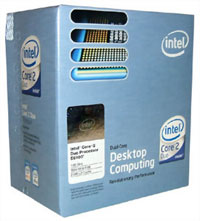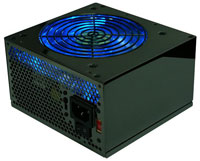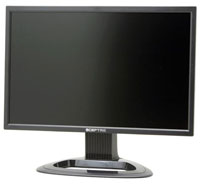Upgraded Midrange Configuration
We've covered our basic recommendations, but of course there's a lot of fine tuning that can be done. The price bracket that can be defined as being midrange is pretty large; some people feel midrange is closer to $1000 while others feel it's closer to $2000. We would say $2000 is more of a high-end configuration, but as we mentioned earlier you don't need to purchase every upgraded component when customizing your own midrange build. Here then are the upgraded midrange recommendations.
| Intel Mid-Range Performance System |
| Hardware |
Component |
Price |
Rebates |
| Processor |
Intel Core 2 Duo E6600 (2.40GHz 4MB Shared) - Retail |
$317 |
|
| Motherboard |
ASUS P5B-E (P965 775) |
$151 |
|
| Memory |
Super Talent 2x1GB DDR2-800 (T800UX2GC4) |
$268 |
|
| Video Card |
Sapphire Radeon X1950XT 256MB (100186L) |
$256 |
$30 |
| Hard Drive |
Western Digital 500GB SATA 3.0Gbps 7200RPM 16MB (Caviar SE16) |
$148 |
|
| Optical Drive |
LG Black 18X DVD+R (GSAH22N-BK) |
$36 |
|
| Case |
Lian Li PC-7B plus II |
$103 |
|
| Power Supply |
Rosewill SLI 600W (RP600V2-S-SL) |
$73 |
|
| Display |
Sceptre x22wg-Gamer 22" 5ms DVI+HDMI (1680x1050) |
$365 |
$20 |
| Sound Card |
Creative Sound Blaster X-Fi XtremeGamer 7.1 |
96 |
|
| Speakers |
Logitech Z-5300e 5.1 280W THX Speakers |
$159 |
|
| Keyboard and Mouse |
Microsoft Comfort Curve 2000 B2L-00047 |
$28 |
|
| Operating System |
Windows XP MCE 2005 (with Vista coupon) |
$115 |
|
| Bottom Line |
|
$2115 |
$2065 |
 |
As you can see, we've limited our performance upgrade to the Intel platform. AMD is still be reasonably competitive with the E6600 when using their X2 5000+, but we definitely give the edge to Intel and the prices of those two processors are about the same. A few of the less critical components stayed the same, but we've upgraded almost everything.
The upgraded processor improves clock speed over the E6300 by 28%, and the 4MB L2 cache typically adds another 5% to 15% performance depending on the application. It ends up being about 40% more processor performance for a price increase of 70%, which really isn't that bad in terms of CPU price/performance scaling.
The ASUS P5B-E motherboard isn't going to be noticeably faster than the Biostar 965PT, but it does have some extra features. The ASUS board adds FireWire support, three more internal SATA ports and one eSATA port, RAID 0/1/5/10 support, a slightly different expansion card slot arrangement, and a different onboard audio solution. The ASUS P5B-E is also one of the better overclocking motherboards, especially in its price bracket.
Along with the faster processor and upgraded motherboard, we selected some Super Talent DDR2-800 memory with 4-4-3 timings. The performance benefit of the faster memory probably isn't worth the extra $40 ($70 after OCZ rebate) unless you plan on overclocking, and we will be using this same memory on the overclocking configuration. These Super Talent DIMMs allow for up to 2.2V officially and should come close to matching the performance of many of the $400+ memory kits. Timings will likely need to be relaxed a bit more, but overall they are very good DIMMs.
 |
There are quite a few good graphics cards in the $200-$300 price range, and for the performance configuration we selected one of the faster models. The X1950 XT 256MB is nearly as fast as the full X1950 XTX in most situations, but it's priced about $100 lower. There are a few games and applications that can benefit from having 512MB of memory, but even then the performance difference is rarely more than 10% so the 40% price increase is hard to justify. Anyone interested in running a CrossFire setup would need to choose a different graphics card, as there are no 256MB X1950 XT CrossFire cards right now, but we wouldn't recommend CrossFire or SLI as a reasonable gaming solution unless you are already running at least a GeForce 8800 GTS or faster graphics card.
 |
The hard drive, power supply, and display upgrades all take the same approach: bigger is better! If you're not the type of person to fill even a 250GB hard drive, obviously the hard drive upgrade is unnecessary. The Rosewill 600W power supply is probably overkill, but users who plan on adding multiple hard drives and perhaps a second graphics card in the future probably won't feel too bad about spending an extra $10. Whether or not the Rosewill 600W is really that much better than the Fortron Source 450W is debatable, but most people have been pretty pleased with the midrange Rosewill offerings. Just be aware that they aren't particularly quiet.
 |
The 22" LCD has the same resolution as the 20" LCD in our base configuration, but it does have a few other advantages. The Sceptre x22wg-Gamer boasts a 5ms response time (versus 8ms), but more importantly it includes HDCP support and it also has an HDMI input. Acer offers a couple of similar 22" LCDs that are worth considering, and if you are primarily concerned with image quality we would rate them as being more or less equivalent to the Sceptre (most of the 22" LCDs use the same panel after all). For $50 less you can forget all about HDCP support and just get a standard LCD, or you can save $20 and still get HDCP but drop the HDMI port. Several other companies offer similar LCDs, with prices ranging from $300-$400, but if you want to get something larger than a 22" LCD the next step up will be the 23" and 24" models that cost at least twice as much. We'll save such displays for the High-End Buyer's Guides.
 |
The last two upgrades are a change of case and improved audio, neither of which are truly a critical upgrade. The Lian Li cases do look nice and they are invariably very high-quality designs, and the PC-7B Plus II has been popular for quite some time. Unlike the basic case, the Lian Li features an aluminum construction that reduces the weight and helps to avoid sharp edges on the interior. It also comes with two 120mm fans which should help to provide exceptional cooling for all but the most demanding builds. The drawback of the two fans is that they do tend to create more wind noise, but you can always unplug the front fan if that's a concern.
 |
As for the speakers, the Logitech Z-5300e speakers certainly sound better than the cheaper Logitech X-530, but they also take up more space. The subwoofer in particular is very large (as is the remote), and for many environments the sound output may be overpowering. There's also no point in investing in really nice speakers if you don't intend to use a higher-quality soundcard, which is why we've included the Creative Sound Blaster X-Fi XtremeGamer. The X-Fi will primarily help in gaming applications, but it does provide cleaner audio than onboard solutions as well. Multimedia enthusiasts might also be interested in adding a TV tuner card, in which case we would look towards either the NVIDIA DualTV, ATI Theater 650, or one of the Hauppauge offerings.
Altogether, the various performance upgrades add almost $800 to the total cost. We do feel that every one of the upgrades is justifiable, but most people probably aren't looking to spend upwards of $2000 on a new computer. This is definitely a high-end configuration rather than a midrange system, but we wanted to give a list of good potential upgrades without drifting off into long-winded debates about which upgrades are the most important. If you want a good start to a high-end computer, you can of course take this list and run with it you will be very pleased. If you want more of a middle ground, the speaker, case, motherboard, and memory upgrades are the first areas we would look to trim costs.


















43 Comments
View All Comments
JarredWalton - Sunday, January 21, 2007 - link
Some of the PCs are kept up to date for gaming parties and the like. Others are just mostly sitting around waiting for me to test something on an older platform or whatever. Others are basically spare parts. In the winter, I turn on a lot of them to provide heat - I only have electric heaters anyway, so whether I'm putting the electricity into the heaters or into PCs doesn't make much difference to me. I run Folding@Home in such cases to increase heat output, and if the house starts getting too warm I shut down systems. :)chrnochime - Friday, January 19, 2007 - link
Basic Config - AccessoriesBoth times that Fortron appeared, it was written as "Fotron". FSP would probably appreciate that you spell their name correctly....
JarredWalton - Friday, January 19, 2007 - link
Awesome! I've been misspelling their name for years and this is the first time anyone has corrected me. Oops! Thanks -- I will see to it that they don't make that mistake again. :-)JarredWalton - Friday, January 19, 2007 - link
Speech recognition. "they" = "I"noxipoo - Friday, January 19, 2007 - link
should be around $1500.screech - Friday, January 19, 2007 - link
basic midrange page:" With either of the above systems, you should easily be able to run all current applications, along with Windows Vista, with one possible exception: games. You can even run all current games,"
Perhaps a little rewording is in order? ;)
JarredWalton - Friday, January 19, 2007 - link
Not sure what you mean - maybe I'm just blind. Basically, you can run all current games, but not at maximum detail, hence it's a "possible exception".dqniel - Friday, January 19, 2007 - link
Rosewill PSUs? Absolutely awful. OCZ S.O.E. ram? Horrible track record with C2D chipsets and a poor price to performance ratio. G.Skill "HK" series RAM for the OCing system? 2x1GB kits using Micron D9 are available for the same price. A $267 Super Talent kit on Newegg for example. Asus P5B-E 1.02 motherboard? Not even available in the U.S. OCZ GameXStream PSU? Such horrible voltage ripple problems that I wouldn't trust it in a budget rig. The Corsair 520w or Zalman 600w would be much better choices.I'm confused as to how this thing got past quality control and was published.
JarredWalton - Friday, January 19, 2007 - link
Several editors felt the G.Skill RAM was a good choice, but the Super Talent is arguably just as good if not better. Considering the G.Skill is now out of stock, I'll switch the RAM to the Super Talent - which is not Micron D9 memory as far as I'm aware, but still uses Micron chips and performs quite well (unless you're looking at some other ST memory?). The OCZ S.O.E. mostly suffered from early P965 BIOS issues, and with the rebate it comes in as very good RAM for a relatively low price. If you don't like rebates, we would suggest other DDR2-800 RAM price at around $200, which will perform about the same (within 2% most likely). As for the rest...There are about five different 700W PSUs available that are all based off the 700W Fotron Source. OCZ GameXStream is the cheapest at present, and despite your concerns with the "horrible voltage ripple" we have found the PSU to work extremely well in various systems. The overall experience most people have had with this PSU is very good - no product is perfect, and there will always be a few bad units out there - and for the price it's difficult to say that any PSU is universally better. You can get quieter PSUs (with lower wattage ratings - although those are mostly hype), and the Corsair 520W you mention is a good PSU. Is it better, though? That's difficult to say.
The Rosewill PSU is in a different boat. Every time anyone recommends a PSU from some lesser brand, criticisms are sure to come. Rosewill PSUs in our experience are decent, and while Deer Electronics or Solytech or whoever may be the OEM, companies can and do get better. I've got one of the Rosewill 600W PSUs running a system and I've had no complaints with it. I haven't tried to overload the PSU to make it fail, but it appears to be about as good as several other ~550W PSUs I have (in terms of efficiency) and it's quite a bit cheaper. It's also a bit more noisy, but when you've got CrossFire X1900 GPUs most other fans are quiet by comparison. When it can run a CrossFire setup without any issues, that's pretty good for a $75 PSU. Of course, I'm not a PSU reviewer, but http://www.jonnyguru.com/review_details.php?id=48">JohnnyGuru took a look at a 500W Rosewill so maybe you'll trust his results? Not bad for a budget PSU, and it's probably safe to say the 600W listed in this BG is of similar quality to their 500W unit.
Finally, for the motherboard I've listed the DS3 and the P5B-E, on the recommendation of Gary as he tends to do most of our motherboard reviews and he's tried all of the boards. My understanding was that the 1.02G is available in the US, but perhaps you're right. The P5B-E still offers a few features other boards lack at that price point, so depending on whether you prefer better OC'ing (DS3) or features will determine which board is right for you.
If singling out 5 components out of 31 that you dislike turns an article into a horrible mess that's not worthy of publication, I'm sorry to disappoint. I can't say for certain that every one of these components is best in class and will work with every possible system configuration out there (i.e. motherboards can be picky about RAM at times), but I can say that the configurations listed will work very well according to our testing of the various parts. Most of the criticisms you've brought up will hardly make a difference on the final result.
dqniel - Friday, January 19, 2007 - link
Let me first state that perhaps I exaggerated a bit. I didn't mean to imply that the guide was "a horrible mess." Simply put, I think the guide is below Anandtech's standards in terms of having nearly perfect product selection in the given price range. Why settle for "...will hardly make a difference on the final result" when you can squeeze out that extra little bit of performance and stability for your money?I'm sticking by my Super Talent remark in that it has D9GMH chips: http://www.newegg.com/Product/Product.asp?Item=N82...">http://www.newegg.com/Product/Product.asp?Item=N82... (this particular model)
Secondly, I'm glad that you could inform me that most of the S.O.E. problems have been fixed by BIOS updates. I'm sure either the S.O.E. or similarly priced Adata would be perfect choices for the rigs.
As far as the PSUs are concerned- as I'm sure you know, most PSU companies will use varying OEM manufacturers from model to model. The particular Rosewill PSU you chosen, because of the poor choice of OEM manufacturer, for the 600w unit is well below the standards of other budget PSUs such as the Enhance GH models available at the reputable www.ewiz.com. Secondly, there is no reason to get a 700w PSU for the system you suggested even with heavy overclocking thrown into the mix. Power consumption is blown out of proportion and quality is greater than quantity since most companies' units don't actually meet their specified outputs. Because of this, a $120 Corsair HX or $120 Zalman 600w would be a better choice. Adequate power with better quality in terms of ripple while costing less seems like a logical choice. Sure, ripple won't cause any performance problems in the short term, but Jonnyguru and others have stated that in the long run it leads to the death of sensitive components such as RAM. The FSP Epsilon-based units are some of the worst available (with the exception of the Zalman unit) in terms of putting out dangerous ripple.
The P5B-E 1.02 was renamed after the article you guys published. It was released overseas as the P5B-E Plus and is impossible to find in the states without paying ludicrous amounts. The Gigabyte DS3 and P5B-E Deluxe are both fantastic and widely available, however.